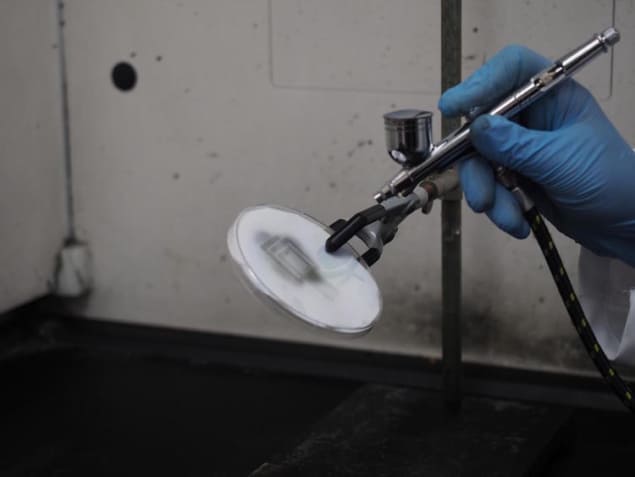
Radio-frequency (RF) antennas, which are used in the Internet of Things, could now be created using a simple, one-step spray-on technique thanks to new work by researchers at Drexel University in the US. The antennas, which are tens of nanometres to a few microns thick, are made of titanium carbide – a material that belongs to the family of 2D transition metal carbides and nitrides known as MXenes – and could allow any object to become connected.
The MXenes have the chemical formula Mn+1Xn, where M is an early transition metal (such as titanium, vanadium, niobium and molybdenum) and X is carbon or nitrogen. They were discovered by the Drexel researchers in 2011, who have been studying them since. Now, the team, led by Yuri Gogotsi of the Department of Materials Science and Engineering, says that the MXene titanium carbide (Ti3C2) can be dissolved in water to create a highly conducting ink or paint.
This coating can transmit and direct radio waves even when it is applied in a very thin coating, say the researchers, which means that it could be sprayed onto a variety of objects and surfaces, be they rigid or flexible, without adding additional weight or circuitry. “This is a first, since current fabrication methods of metals cannot make antennas thin enough and applicable to any surface, in spite of decades of research and development to improve the performance of metal antennas,” says Gogotsi.
In their experiments, the researchers made a 100-nm-thick translucent MXene antenna using the conducting Ti3C2film. They designed their device to work at 2.4 GHz, which is the frequency used for Wi-Fi and Bluetooth applications. This antenna has a reflection coefficient (the ratio of the reflected wave’s amplitude to the incident wave’s, or how much energy is reflected) of less than -10 dB. By then increasing the antenna’s thickness to 8 μm, the team measured a reflection coefficient of -65 dB, which is 98% of its predicted maximum value.
Current flow is skin deep
The new antennas are as good as their traditional, but much thicker, counterparts made from metals like gold, silver, copper and aluminium, whose performance is limited by an intrinsic property known as the skin depth, say Gogotsi and colleagues. This is the thickness of the material through which the electrical current responsible for the RF radiation actively flows. In copper, for example, the skin depth at 2.4 GHz is 1.33 μm, while for silver and aluminium, the values are 1.29 and 1.67 μm respectively. This means that the thickness of antennas made of these metals should be at least 5 μm to allow for sufficient space through which current can flow, and this can prove to be too big for some wearable and transparent device applications.
The problem of skin depth can be overcome by using materials like conductive polymers or nanomaterials, such as graphene and carbon nanotubes, in such antennas, but the snag here is that these are poorly conducting. According to Gogotsi’s team’s measurements, the new MXene antennas are 50 times better than graphene and 200 times better than silver ink antennas when it comes to preserving the quality of radio wave transmission.

2D MXenes make photonic diodes
“The MXene antenna not only outperformed the macro and micro world of metal antennas, we went beyond the performance of available nanomaterial antennas, while keeping the antenna thickness very low,” says team member Babak Anasori. “And, unlike other nanomaterials fabrication methods, that require additives, called binders, and extra steps of heating to sinter the nanoparticles together, we made antennas in a single step by airbrush spraying our water-based MXene ink.”
The researchers have already successfully sprayed their antenna ink onto rough surfaces like cellulose paper and smooth ones like polyethylene terephthalate (PET) sheets. They say they would now like to find the best ways to apply it onto a wider variety of surfaces, including glass, yarn and even skin. They report their work in Science Advances 10.1126/sciadv.aau0920.



